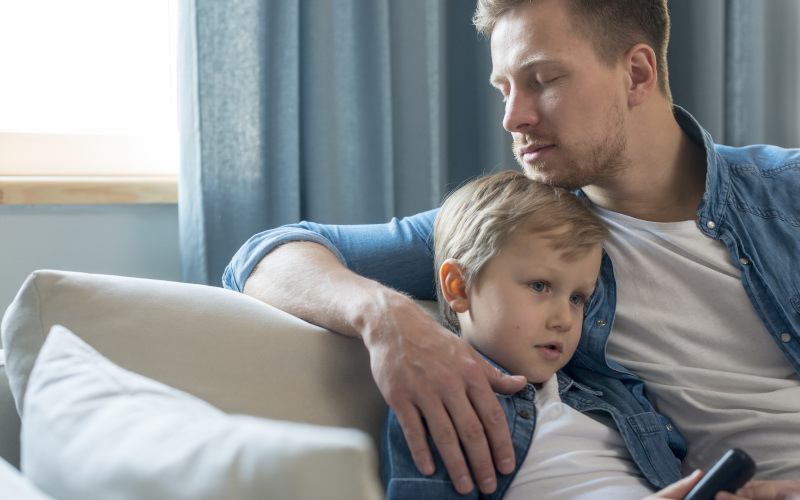Written by Justin Wigg ([email protected])
Parenting never stops, but your nervous system doesn’t always get the memo. When you’re running on edge—tired, reactive, wired—it can ripple outward faster than you think. The hard part? You often won’t see it in yourself first. You’ll see it in your child: in the clench of their shoulders, their abrupt change of tone, their sudden refusal to go to school or eat dinner. It starts subtly, but over time, your own anxious signals can become the emotional wallpaper your child learns to live with, or worse, absorb. Here’s how to catch it early, shift your stance, and steady the atmosphere you both breathe.

Spotting early signs in kids
It doesn’t always look like anxiety. It might look like defiance, clinging, over-apologizing, or even just silence. Kids rarely say, “I’m overwhelmed.” Instead, their bodies speak for them. If you’ve noticed more complaints of stomachaches and headaches than usual, that’s worth listening to. It’s not about panic attacks or major meltdowns. It’s about the slow build, the irritability, the overreactions to minor issues, the regression to behaviors they’d outgrown. These are the breadcrumbs. And sometimes, those breadcrumbs trace straight back to the emotional environment at home.
Modeling calm for children
Children don’t copy what you say. They copy what you repeat. If your baseline is tension, theirs will be, too. That’s why it matters when you take a few deep breaths to ease tension—and you let them see you do it. Don’t save your coping strategies for when you’re alone. Narrate them. “I’m feeling rushed, so I’m going to take three slow breaths before we leave.” These aren’t just words. They’re cues. Over time, they become scripts your child can replay when they’re spinning out. Your regulation builds their resilience.
Strengthening through routine
Uncertainty is gasoline for anxiety. Predictability is one of the quietest ways to reduce its burn, especially when it comes to transitions such as bedtime, leaving the house, and starting school. Routines are not about rigidity; they’re about reliability. They tell your child that the world makes sense and that they’re safe in it. Routines can help you remain calm, too. When your brain knows what comes next, it can stop bracing for impact, which can lower your overall reactivity.
Journaling as a mirror
Sometimes the signals aren’t in your child at all; they’re in your journals. Digital journaling, in particular, makes it easier to recognize how your mood shifts across the week, how certain events spike your anxiety, and how that might spill over into your tone or reactions. There’s something powerful about externalizing your internal noise. Writing it down makes it observable. That’s when patterns become visible. And when you organize your entries digitally, then archive them using a PDF maker, it becomes not just self-reflection, but a record of growth. You can revisit past entries, track how your reactions evolve, and use that awareness to consciously re-center.
Show coping skills visibly
You don’t have to be perfect. You just have to be real and responsive. One of the most effective ways to help kids learn to manage big feelings is to narrate your stress‑management steps. That might sound like, “I’m feeling overwhelmed, so I’m going to take a walk to clear my head,” or “Let’s take five minutes without screens so we can reset together.” This kind of modeling doesn’t just teach strategies; it teaches the legitimacy of emotional maintenance. It normalizes the idea that grown-ups have to manage their feelings, too. And it gives kids the language and permission to do the same.
Career stress and long-term anxiety
Sometimes the source of your anxiety isn’t in the home but the workplace. If your career situation consistently spikes your stress, it might be time to explore a different trajectory. This is worth exploring if your work conditions erode your patience, energy, or ability to show up at home. For example, working towards a degree or certification can open up more opportunities for you, regardless of your profession. Online degree and certification programs also make it easier to handle parenting and work duties without burning out..
Bring presence into chaos
It’s easy to disappear even when you’re right there. Phones buzz, dishes pile up, the to-do list expands, and suddenly, your child’s voice fades into background noise. But the most powerful balm for a child’s anxiety is presence. Not just being in the room, but attuned. When you slow down and anchor into mindful parenting, you remind your child (and your own nervous system) that this moment is enough. You don’t have to fix the future. You just have to meet what’s here with clarity, breath, and care. And that changes everything.
You are the emotional climate. Your tension forecasts theirs. But that also means your calm can clear their skies. This doesn’t require transformation. It requires attention. Attention to your body, your routines, your coping habits, and the signals your child sends when your worry becomes contagious. Start with breath. Start with small rituals. Start with noticing. And from there, recalibrate. Because in the end, your ability to soften your own edges teaches your child they can too.
Discover compassionate and tailored counseling services at Georgia Family Crisis Solutions, where experienced counselors are dedicated to helping you and your loved ones overcome challenges and find hope for a brighter future.

